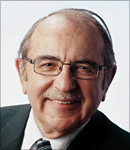This is the first installment of our 3-part interview with Dr. Russell Lefevre, a widely recognized IEEE Smart Grid technical expert and chair of the IEEE Steering Committee on Electric Vehicles. Dr. Lefevre is an IEEE Fellow, past president of IEEE-USA, and a member of the American Association for the Advancement of Science and the Aerospace and Electronic Systems Society of IEEE. The interview is conducted by Jon Brock, EnVision 2030 Contributing Editor. This initial session addresses the roles that electric vehicles will play in the future of Smart Grid and the benefits they can provide. Some of the pertinent issues around consumer acceptance of these new and emerging electric vehicle technologies are also discussed. Parts 2 and 3 – appearing in the July-August and November-December 2012 issues – will delve deeper into other facets of V2G development and deployment; be sure to watch for them!

Dr. Russell Lefevre
IEEE Fellow

Jon Brock
EnVision 2030 Contributing Editor
Brock : Let’s start with a very basic foundation question: How and why are electric vehicles important to the Smart Grid?
Lefevre : Actually, they are vital to the Smart Grid. There are plenty of reasons why, but one of the key things is that they appeal to major, but dissimilar, communities. Here’s what I mean by that: Electric vehicles appeal to environmentalists because most studies show there is a “plus” with respect to the EV carbon footprint. The Pacific Northwest National Laboratory has examined nine scenarios examining the impact EVs will have on the environment, and all showed a significant reduction in greenhouse gas (GHG) emissions, even when the required increase in electric power needed to supply energy to these vehicles was generated in large part from coal-fired power plants, which have inherently high GHG emissions.
Another community consists of those in major developed countries such as China, Australia, Western Europe and the United States that are concerned about importing oil that has inherent price fluctuations and comes from what we’ll call ‘unreliable’ countries. To the extent that Electric Vehicles (EV) are deployed, the dependence on oil is reduced.
Brock : What do you feel is the most important message utilities should communicate about the adoption of electric vehicles and their impact on the Smart Grid?
Lefevre : The most important message is based on a couple of quotes I’d like to share with you.
First, the U.S. Department of Energy National Renewable Energy Laboratory (NREL) has taken the position that: “Large scale deployment of plug-in electrical vehicles will have limited, if any, negative impact on electric power generation requirements.”
And EPRI said: “If plug-in electric vehicles displace half of the all vehicles on the road by the year 2050, they would require only an 8 percent increase in electricity generation – and just a 4 percent increase in capacity.”
What these quotes say is that if you look at the four elements of the grid – generation, transmission, distribution and consumption – it is very hard to find anybody who has any concerns about generation and transmission. There are, however, significant questions about distribution.
Brock : What are those questions about distribution?
Lefevre : The concern is not about the potential impact on a large aggregated scale, but rather at the neighborhood level. If you have two PHEVs in a neighborhood with three houses and these PHEVS are charging at Level 2 – which uses a 240-volt outlet with a current of maybe 20 to 30 amps – and you start a clothes dryer, you put a significant stress on the transformer serving those houses. This issue is called clustering. It is very scenario-dependent, but it is important. PG&E estimates that PHEV charging at Level 2 (240 volts) is comparable to the average peak summer load of a single home.
Brock : Are there any solutions at hand to address this clustering issue?
Lefevre : Many solutions are being developed. The Smart Grid itself can use demand-response techniques to slow charging, turn it off or relieve the stress on the transformer in some other way. Load-management techniques such as time-of-use tariffs can be employed to motivate people to charge EVs at night.
Brock : But nighttime charging creates other problems, does it not?
Lefevre : Yes, widespread charging at night will change demand on the grid. Many transformers are designed to cool at night, so if you put a significant load on those transformers at night the equipment can’t cool down, which can shorten its useful life. This is another item utilities are looking at.
Brock : Could these concerns affect customer adoption?
Lefevre : At this point, most consumers are not really concerned about whether the grid can handle it or not, so it would probably not enter into their EV buying decisions. What most consumers are worried about is cost, and the industry is working on that. Consumers get tax breaks and other kinds of incentives to purchase EVs. Consumers are also concerned about conveniences associated with charging and EV range. Surveys reveal that customers don’t want utilities telling them when to charge their vehicles. They want to come home at 6 p.m. and plug in, which further underscores the clustering issue.
Consumers are concerned about availability of charging stations in towns and along highways –and that charging takes too long. The length of time is dependent on the battery. For a 16kWh battery such as in the Chevrolet Volt, Level 1 charging – which is designed for home use – takes about ten to twelve hours, Level 2 (for home or public charging) takes two to four hours. Level 3, for very fast charging, will be of vital importance for charging at outside public locations and along highways, yet at this time nobody really knows what the Level 3 will be. There are no standards, although some fast chargers are already being deployed.
Brock : What would you say are the top concerns about widespread adoption of Evs?
Lefevre : Concern number one – and all the rest of them are lower-level concerns – is not about the potential impact at a large aggregated scale, but at the neighborhood level. As discussed earlier, this is where you might have problems. At the “EV Charging Infrastructure USA 2011” Conference, the people who spoke there were all from utilities or commissioners who deal with utilities, and virtually all of them talked about this clustering issue. IEEE has some notably important researchers, and one of them – Saifur Rahman from Virginia Tech – has studied this issue. It can be a really serious problem that practically everybody recognizes and one for which nearly everyone has a different solution.
Brock : Can you perhaps elaborate a little on what some of those solutions might be?
Lefevre : One solution with direct linkage to Smart Grid has the grid sensing when the transformer is on the verge of being distressed and sending signals that will slow the charging, turn it off for awhile, or possibly initiate other measures to relieve the stress on the transformer. This might include curtailing loads as part of the utility’s Demand Response scheme.
With the Smart Grid it is possible to also affect household electric elements. At a Society of Automotive Engineers workshop, it was suggested, for example, that perhaps a swimming pool heater or some other non-essential energy load could be turned off while the vehicle is charging. There are also other viable ways to do this that involve time-of-use charging, charging at night, and cycling air conditioning. All those sorts of things can help minimize potential problems at the distribution level.
Brock : Any other concerns?
Lefevre : As I said, the top concern that I’ve been talking about here is clustering; the rest of the concerns are somewhat lower in importance, but billing and payment is another one keeping people up at night. That is, electronic communications with EV users will introduce some privacy and billing concerns. Utilities will need to identify EV users in order to bill them, because you can’t have a user driving around a city’s streets, deciding that they need to charge their EV, pulling up to a charging station, taking out their extension cord, and plugging it in. So then, how does the user pay for power in this scenario, and who gets access to that location data?
Brock : That does seem like a potential issue and one that has not yet been talked about very much – at least not in the public forum. What still needs to be done for a viable billing scheme to be worked out?
Lefevre : For any billing solution to work you first have to know who the user is. This is not an insignificant concern. Southern California Edison is working hard on this, and its experts say that between 2012 and 2015, the company will have separate metering for charging systems in residences, which will be different than metering used for the rest of the house. And they will have public charging and a lot of other services by 2015. Between 2015 and 2020, they will introduce “pay-at-the-charging-point” options. They’re going to figure out exactly how to charge a person who plugs into a public charging station. Beyond 2020, they envision a whole suite of other services and conveniences that they’re going to introduce to bring electric vehicles into the utility environment.
Brock : How do you see the Smart Home model fitting – or not fitting – into this environment?
Lefevre : The Smart Home, which is directly related to the Smart Grid, of course, will also introduce some concerns because the Smart Home will need a local energy management system and the ability to activate time-of-use tariffs to support EVs. Utilities need to determine how to implement these properly. That is, utilities will have to determine how to implement smart charging, which is integrated with the Smart Grid to reduce the charging rate or change the charging time to help alleviate both the real – and the perceived – clustering issue.
Brock : What are some of the other issues out there?
Lefevre : Another concern is integrating EV charging with renewable energy resources. This is a big deal because environmentalists believe that in the long term, EV charging will likely take significant advantage of renewable energy. Utilities are still developing a vision and methods to make these approaches effective and practical.
Brock : Thank you, Dr. Lefevre, for your valuable insights about EVs and their adoption. We look forward to continuing this dialogue in the future on other EV-centric topics such as regulatory issues, energy policy and the myriad technical issues related to EV evolution and deployments.
Lefevre : You are welcome, Jon. The pleasure is mine…
[Jon Brock is president of Desert Sky Group LLC, an advisory firm based in Denver, Colorado, providing independent and unbiased advice and consulting services to the utility and energy industry. Jon also serves as EET&D Magazine’s EnVision 2030 contributing editor and is a longstanding member of the Smart Grid RoadShow Conference Program Committee. EnVision 2030 interviews and presentations are focused on the long-term evolution of the Smart Grid and grid-related technologies.]







